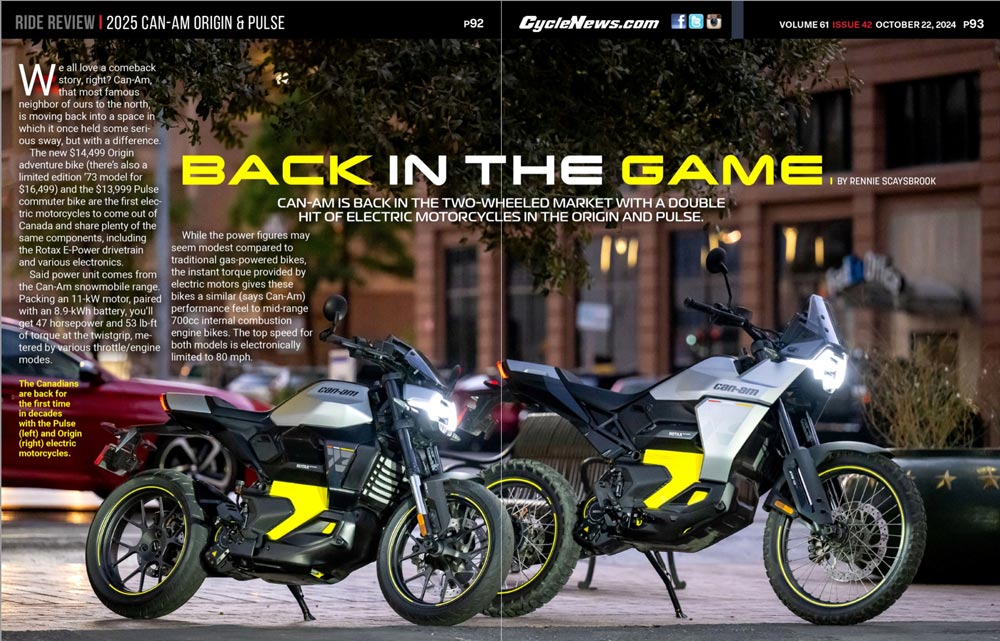Rennie Scaysbrook | November 3, 2024
We all love a comeback story, right? Can-Am, that most famous neighbor of ours to the north, is moving back into a space in which it once held some serious sway, but with a difference.
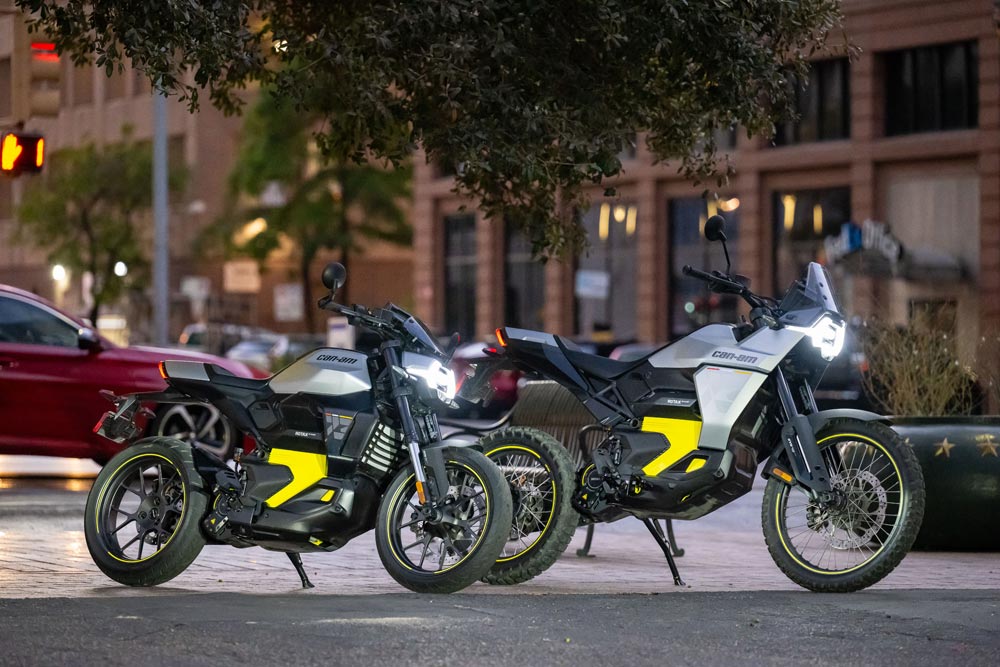 The Canadians are back for the first time in decades with the Pulse (left) and Origin (right) electric motorcycles.
The Canadians are back for the first time in decades with the Pulse (left) and Origin (right) electric motorcycles.
The new $14,499 Origin adventure bike (there’s also a limited edition ’73 model for $16,499) and the $13,999 Pulse commuter bike are the first electric motorcycles to come out of Canada and share plenty of the same components, including the Rotax E-Power drivetrain and various electronics.
Said power unit comes from the Can-Am snowmobile range. Packing an 11-kW motor, paired with an 8.9-kWh battery, you’ll get 47 horsepower and 53 lb-ft of torque at the twistgrip, metered by various throttle/engine modes.
While the power figures may seem modest compared to traditional gas-powered bikes, the instant torque provided by electric motors gives these bikes a similar (says Can-Am) performance feel to mid-range 700cc internal combustion engine bikes. The top speed for both models is electronically limited to 80 mph.
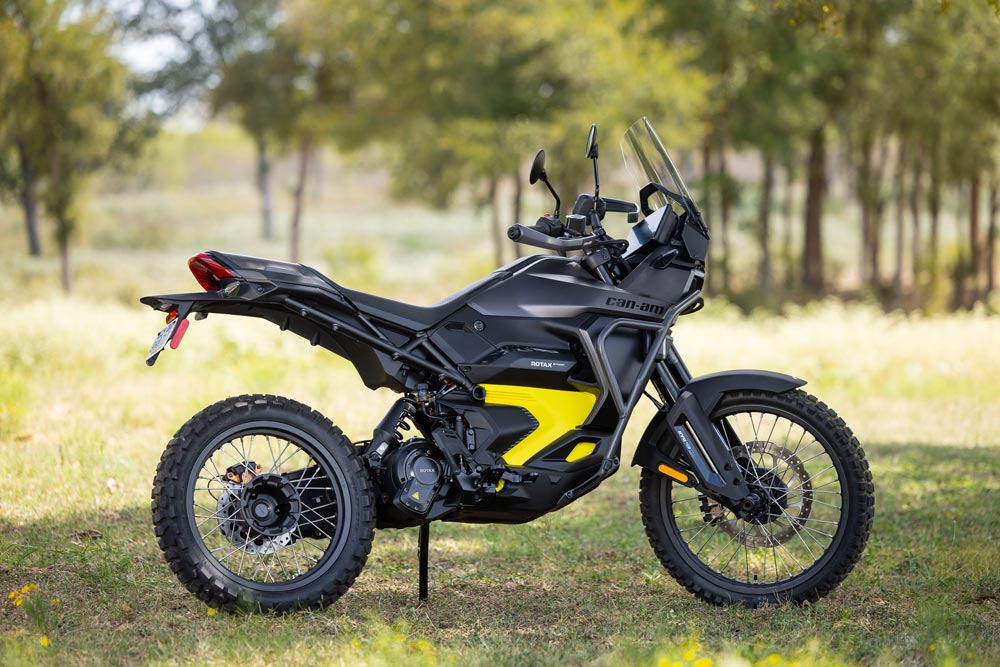 The Origin adventure bike works surprisingly well off-road but on-road performance is quirky.
The Origin adventure bike works surprisingly well off-road but on-road performance is quirky.
For those who haven’t ridden an electric motorcycle before, the number one drawcard is that instant forward propulsion. Crack the throttle from dead-closed and wind it out. You’re silently propelled into your near future at a rapid rate of knots, and with no gearbox to worry about, torque is never interrupted.
Four modes are available on the Pulse in Normal, Eco, Rain and Sport+, while the Origin gains some off-road modes in the extra Off-Road and Off-Road+. The motor is mounted inside the swingarm, allowing constant chain tension from the snowmobile-derived final drivetrain encased inside the swingarm, with the added benefit of less maintenance for the owner. This also reduces rear suspension squat under acceleration by a claimed 95 percent, making for a more stable ride when you get hard on the electric throttle.
The characteristics of an electric drivetrain are especially nice in city/high-traffic situations. No clutch to worry about, also no heat coming off the engine, which on a 110°F (yes, 110°F) day in downtown Austin was a seriously welcome thing.
I started out the day on the Pulse, the naked-bike version of the two. The Pulse runs an extremely low seat height of 30.9 inches, meaning if you’re over six feet tall, long rides will not be in your wheelhouse due to the cramped rider triangle. But then, no long rides will be in your wheelhouse due to the available battery range, but more on that later.
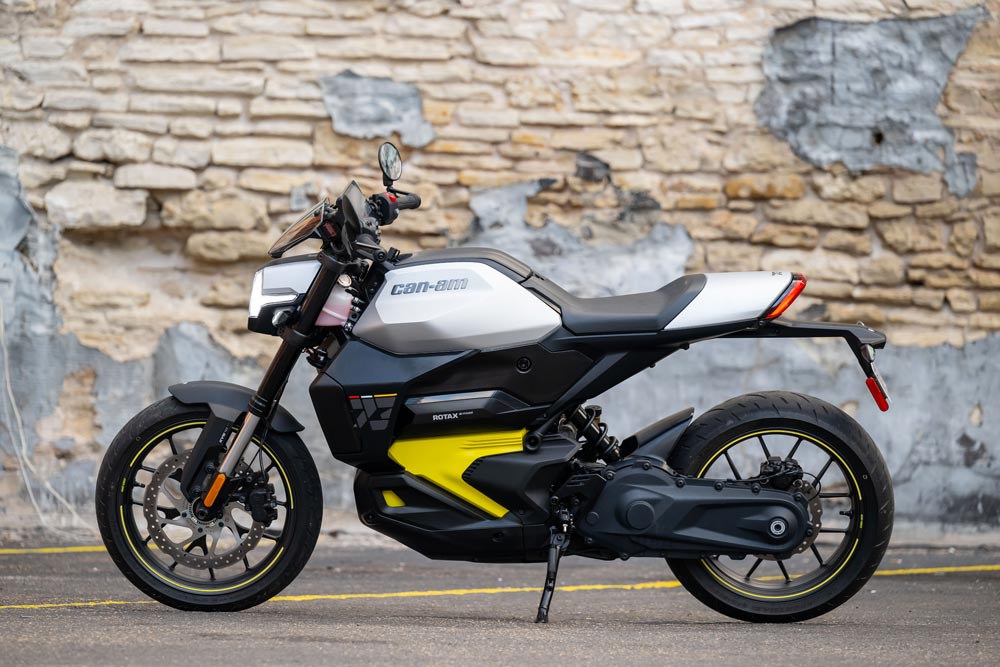 Just like the Origin, the Pulse’s motor is mounted within the swingarm. The chain is straight off the BRP/Can-Am snowmobile range and encased in its own unit for reduced maintenance.
Just like the Origin, the Pulse’s motor is mounted within the swingarm. The chain is straight off the BRP/Can-Am snowmobile range and encased in its own unit for reduced maintenance.
Steering geometry is much steeper on the 399-pound Pulse, with 27.2° rake versus the ADV Origin’s 30°, allowing you to really hammer the Pulse through the twisties. It handles reasonably well for an electric motorcycle, although the problem of the slight dead feeling at the initial part of turning isn’t as pronounced as it is on the Origin.
The Origin sits much taller thanks to its 21-inch front and 18-inch rear wheels compared to the Pulse’s 17-inch wheel set. This, combined with the higher placement of the battery within the chassis, makes for a strange feeling when you initially start to turn while on the tarmac.
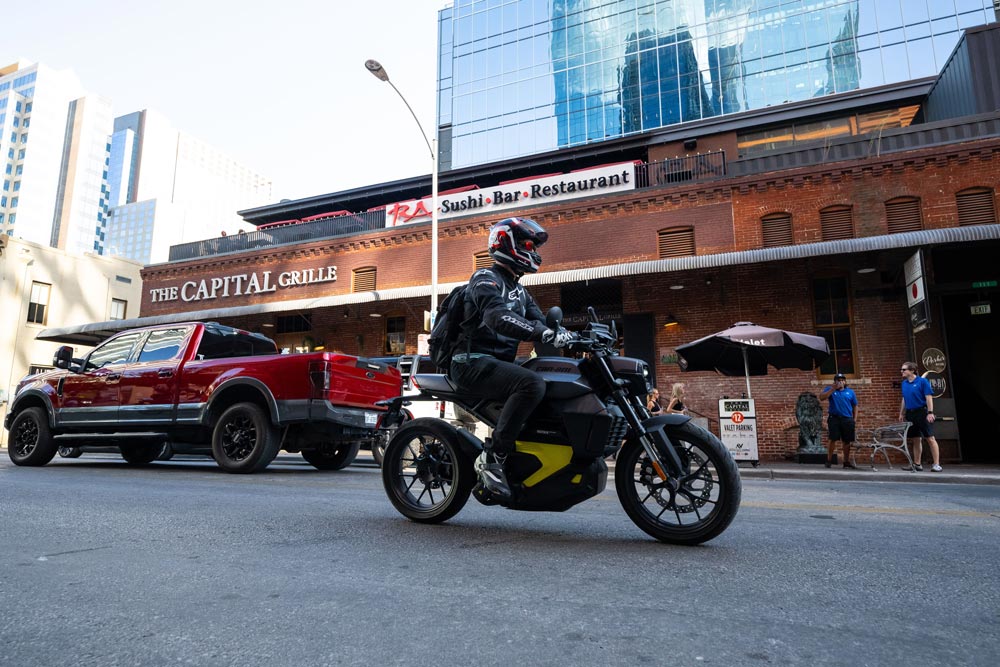 City riding is a cinch on the Pulse, but the seat comfort leaves a little to be desired.
City riding is a cinch on the Pulse, but the seat comfort leaves a little to be desired.
At this point, there’s a void feeling, a brief period where it’s hard to tell what the bike is doing underneath you due to the high center of gravity. The feeling quickly returns once you’re past the first second of turning, but it’s most certainly there and can be a touch unnerving.
Here, the Origin reminded me very much of early Zero Motorcycles in how they would steer thanks to the excessively high weight inherent with a battery design. This is something Zero gradually developed out over the years, so I’m sure Can-Am will do the same as they gain more two-wheeled development and experience.
However, off-road the 413-pound Origin is surprisingly fun and agile. We stopped in at an off-road facility outside of Austin and put it through its paces, and regardless of its on-road behavior, the Origin held its own on the dirt quite well.
The off-road-oriented D605 tires certainly helped here, and I think the fact you’re hardly ever bolt upright while on a trail helped that dead feeling on the initial part of the turn.
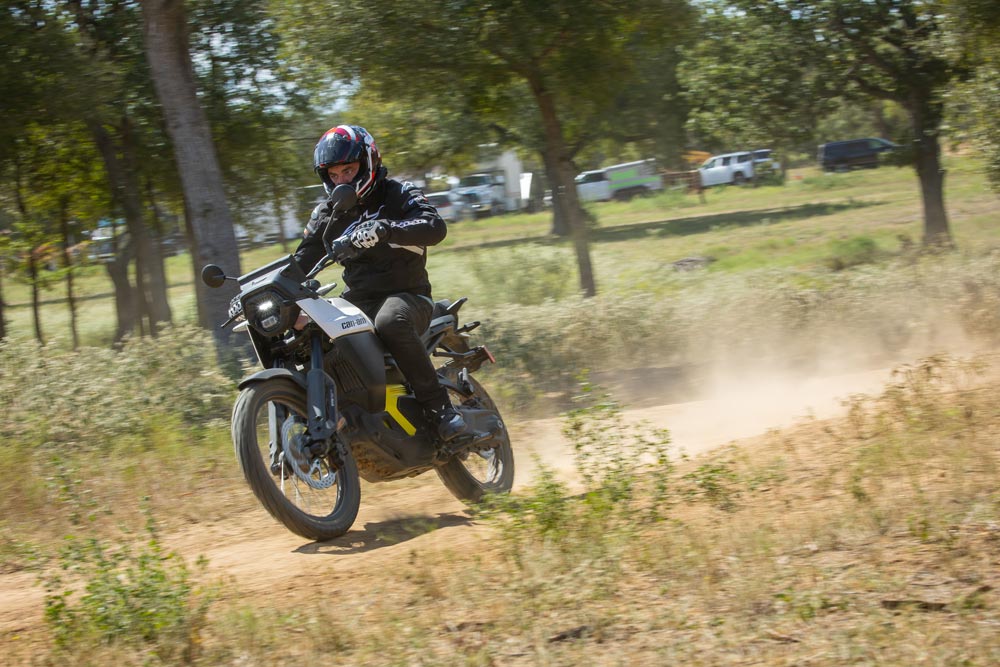 The Origin in its natural habitat. Off-road performance is good but the battery range to get to the trail is an issue.
The Origin in its natural habitat. Off-road performance is good but the battery range to get to the trail is an issue.
The suspension, while soft, soaked up most of the dirt corrugations, although bottoming at the front was a bit of a concern, and the instant torque offered by the electric powertrain made for an enjoyable ride.
The front suspension on both bikes is not adjustable, which needs to be rectified for a machine of this pricing in future iterations. The front on both the Pulse and the Origin offers 5.5 inches of wheel travel and is extremely soft, perfect for tight inner-city riding on the Pulse, but the 41mm fork will spring back too quickly once you start pushing the bike hard under heavy braking.
The brakes are also not up to scratch for the price of the bikes. A single two-piston J.Juan front caliper gripping a 320mm disc is something you’d expect on a machine aimed at teenagers, and what’s more, it’s matched to a master cylinder that doesn’t offer good modulation of the available power. Again, these are easy things that need to be fixed for the near future. The braking is, however, given a helping hand by the very cool passive-and-active regen offered by the electronic motor. Passive is just that—close the throttle and you’ll get a bit of regen braking that will trickle a tiny amount of charge back into the battery.
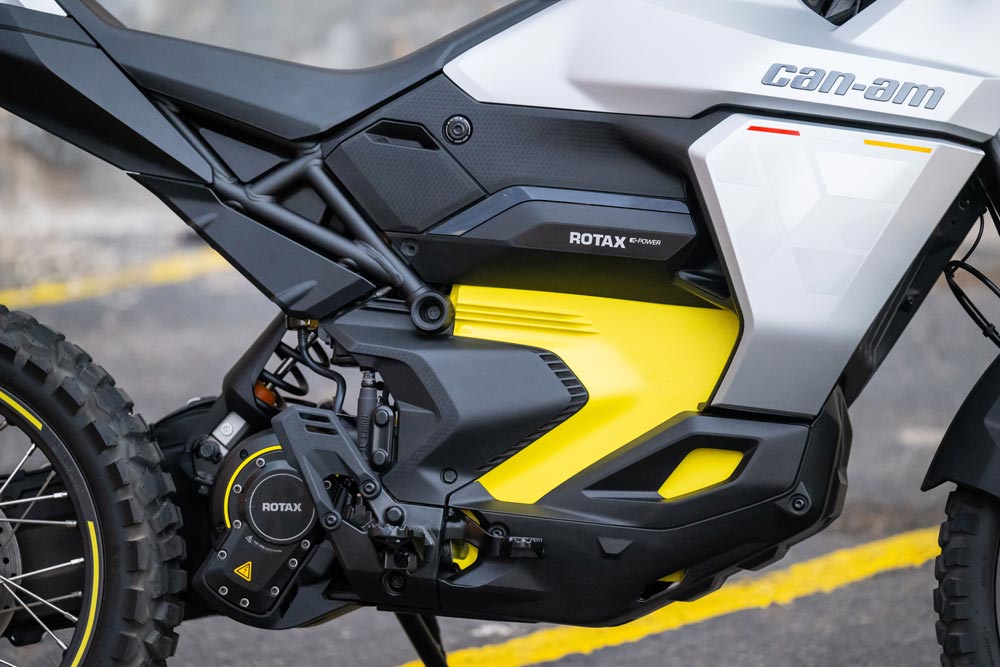 Can-Am-owned Rotax in Austria created the power unit and motor.
Can-Am-owned Rotax in Austria created the power unit and motor.
Active regen, however, is great fun to mess around with. Rotate the throttle past its return point into negative territory and, depending on what regen mode you’re in (one of three), you get a huge amount of speed deceleration without having to touch the brakes. Active regen becomes disengaged when going about 1 mph, but by then you’re on the brakes, anyway.
This brings me to the big elephant in the room that’s always there with electric bikes—range. Can-Am claims that both the Pulse and the Origin will do 100 miles of riding in the city and 71 miles of combined riding. The riding we did in Austin was a mix of city, freeway and backroads, so normal riding conditions in my book. The most I saw out of my range was 61 miles with six percent battery left, so I have to be very dubious (as I always am) about quoted electronics ranges.
Like petrol bikes, electric bikes drain juice faster if you’re going faster, i.e., if you’ve got the throttle pinned or not. If you’re being very timid on the throttle and not winding it out, it’s possible you could get close to the quoted range, but I doubt it.
Can-Am has equipped both models with 6.6-kW chargers that support Level 1 (110V) and Level 2 (220V) charging. On a Level 2 charger, going from 20 percent to 80 percent battery takes about 50 minutes, while a full charge from fully flat to 100 percent can be completed in roughly 1.5 hours. Unfortunately, neither model supports Level 3 DC fast charging, which could be a drawback for riders who need faster recharge times.
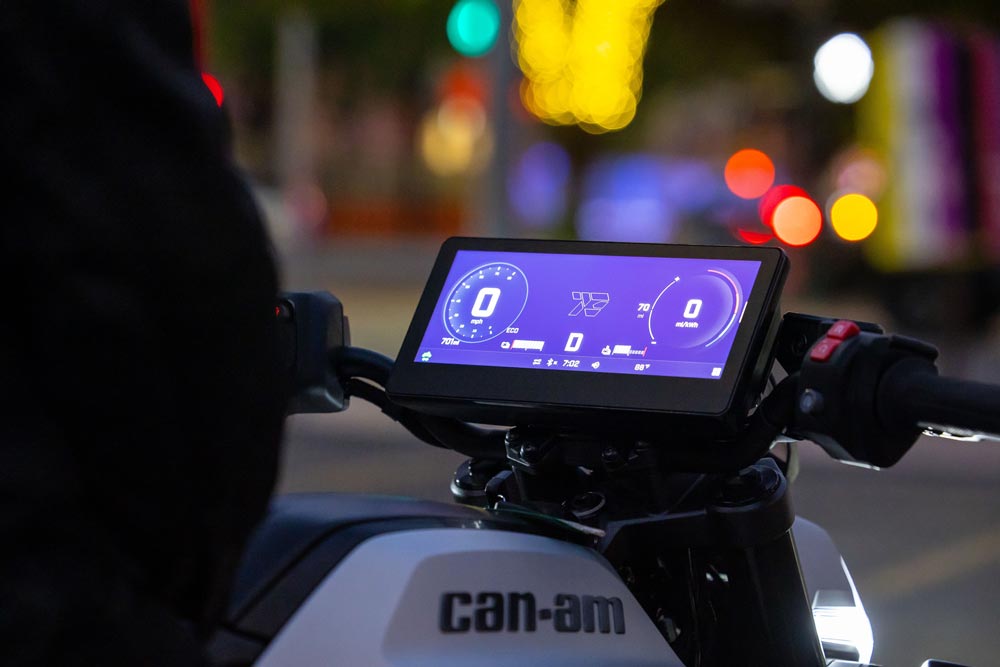 The massive 10.25-inch touchscreen ride-control suite is a nice piece.
The massive 10.25-inch touchscreen ride-control suite is a nice piece.
One of the standout features of both the Pulse and the Origin is the 10.25-inch touchscreen display, which provides access to plenty of information, including navigation, battery levels, and range estimates. The bikes also offer Apple CarPlay integration, with Android support expected soon. Over-the-air software updates ensure that these bikes will stay current with new features and performance improvements as they become available.
Can-Am admits they are getting in at the electric motorcycle ground floor with the Pulse and Origin, and for that, they have to be applauded. However, I’m not yet convinced these two bikes will be genuine alternatives to petrol-powered machines. Given the price and the spec, I’d have hoped for more, but the bones are there. Can-Am will doubtless develop and improve these models over the years, but it will all be for nothing if they can’t get the bikes to go more than 60 miles and have Level 3 charging. For now, it’s a matter of watch this space. CN
VIDEO | 2025 Can-Am Pulse and Origin First Ride

2025 Can-Am Pulse/Origin Specifications
| MSRP |
$13,999/$14,999 |
| Engine |
Liquid-cooled Rotax E-power |
| Battery |
Lithium-ion 8.9kWh |
| Charging |
Onboard charger, 6.6kW (Level 1 & Level 2 compatible) |
| Level 1 Charge Time |
5hr, 15 min for 0–100 percent. 3hr, 10 min for 20–80 percent |
| Level 2 Charge Time |
1hr, 30 min for 0–100 percent. 50 min for 20–80 percent |
| Max Power: |
47 hp |
| Max torque |
53 lb-ft |
| Transmission |
Single speed |
| Chassis |
Engine as stressed member |
| Front suspension |
41mm KYB inverted fork/43mm KYB inverted fork |
| Rear suspension |
Sachs shock, preload adjustable/KYB HPG shock, fully adjustable |
| Front-wheel travel |
5.5 in. |
| Rear-wheel travel |
10 in. |
| Front brake |
J.Juan 2-piston floating caliper, 320mm disc |
| Rear brake |
J.Juan 1-piston floating caliper, 240mm disc |
| Front tire (Pulse) |
Dunlop Sportmax GPR-300, 110/70-17 |
| Rear tire (Pulse) |
Dunlop Sportmax GPR-300, 150/60-17 |
| Front tire (Origin) |
Dunlop D605, 90/90-21 |
| Rear tire (Origin) |
Dunlop D605, 120/80-18 |
| Wheelbase |
55.6 in./59 in. |
| Seat height |
30.9 in./34 in. |
| Weight (curb, claimed) |
390 lbs./412 lbs. |
| Country of Origin |
Canada |
